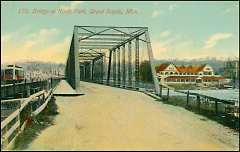
The North Park Bridge as it looked shortly after it was built. The North Park Pavilion can be seen on the other side of the Rive /Photo courtesy Grand Rapids Public Library (78-3-20)
This dispatch was added by one of our Nonprofit Neighbors. It does not represent the editorial voice of The Rapidian or Community Media Center.

The North Park Bridge as it looked shortly after it was built. The North Park Pavilion can be seen on the other side of the Rive /Photo courtesy Grand Rapids Public Library (78-3-20)
By Pete Tabberer
From 1884 until 1903, northern Grand Rapids and the City of Walker were connected by a wooden bridge at North Park Street. In 1903 this bridge was destroyed during flooding on the Grand River and within a year, a new “through Pratt truss” style bridge was built in its place.
For 88 years, the North Park Bridge faithfully did its duty of providing vehicles and pedestrians a way across the Grand River. It was upgraded for heavier loads in the 1930s, and paved in the 1960s. On the whole, the bridge led a fairly uneventful life.
Then, inspections in the mid-1980s revealed extreme deterioration which would require costly upgrades and repairs. The bridge was closed to all traffic in September 1988. This is where its life got interesting.
Plans called for the bridge to be demolished, sold for scrap and then replaced by the four lane concrete bridge that we see today. Local preservationists fought hard against this plan.
The North Park Bridge, at 589 feet, was the longest Pratt truss style bridge in Michigan and was thus eligible for the register of historic places. To get on the list, the Grand Rapids City Commission had to acknowledge its historical significance, which they were reluctant to do.
The bridge had no notable people or events associated with it and it was very similar in both age and style to the Sixth Street Bridge, which had already been preserved, and crossed the river on a much less traveled road.
Preservationists eventually won over State and Federal authorities who decreed that no state or federal funding would be provided for a new bridge unless the old one was somehow preserved.
A compromise was eventually reached: one 116 foot span would be moved to Riverside Park where it would be converted to a pedestrian bridge.
Demolition began in April of 1991, and in March a piece of the bridge was floated downriver on barges and deposited in the park. The city was reluctant to continue with the project and the parks officials were unwilling to spend money on maintenance. So, for eight years it cluttered up the park, rusting quietly, cut off from the public by a chain link fence.
Finally the Federal Highway Administration pressured the cities of Walker and Grand Rapids into holding up their end of the bargain and the bridge was, at last, installed across one of the canals in Riverside Park, where it is enjoyed by pedestrians and cyclists to this day.
It eventually even got the historic marker that the preservationists so desperately wanted. It can be seen in a small kiosk near the south end of the bridge.
The Rapidian, a program of the 501(c)3 nonprofit Community Media Center, relies on the community’s support to help cover the cost of training reporters and publishing content.
We need your help.
If each of our readers and content creators who values this community platform help support its creation and maintenance, The Rapidian can continue to educate and facilitate a conversation around issues for years to come.
Please support The Rapidian and make a contribution today.